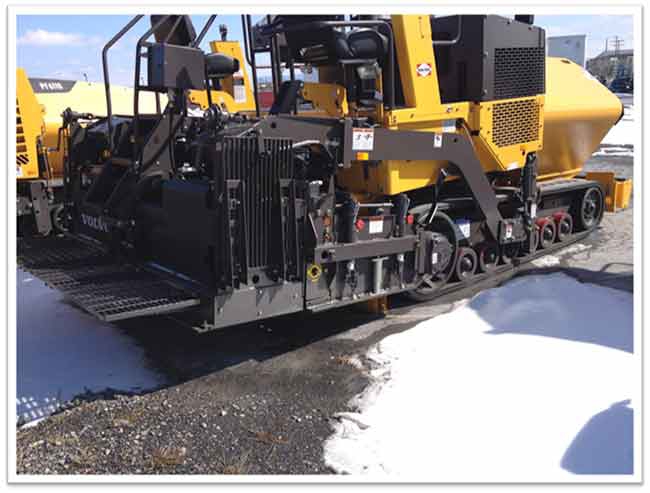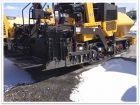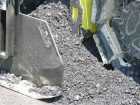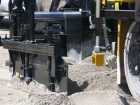
Features
Roads & Paving
Weather Winter
Make the most of your downtime to maximize uptime
December 22, 2015 By John Mooney
 Conducting a full machine audit is vital when preparing paving equipment for the winter weather.
Conducting a full machine audit is vital when preparing paving equipment for the winter weather. December 22, 2015 – For contractors in temperate climates, with winter comes a brief, forced reprieve from the long paving season. However, contractors know well that Jack Frost’s arrival doesn’t mean one can park the paver in storage and expect it to function flawlessly come spring. Even idle time works best when prepared for.
Prep for idle time
Many pavers can be stored outdoors, exposed to the elements. Before flipping the master switch for the season, however, contractors have a laundry list of prep work to complete to ensure their pavers are prepared to sit idle for the winter. After coming off its last job of the year, a paver needs a good cleaning. This involves scraping away any debris or asphalt impeding moving parts, screed extensions, strike off or auger areas, or other parts the asphalt comes into contact with.
In addition to this regular maintenance, a more thorough cleaning will make startup in the spring much easier. Clear out the flow path to ensure that there is no buildup or obstruction interrupting the flow of hot asphalt. Other problem areas worth a detailed cleaning could include under a cab conveyor chain or below hopper wings where augers are driving. An approved cleaning agent should be used for this more rigorous cleaning.
Draining the fuel tank and refilling it with a winter blend will prevent the fuel from turning to sludge at cold temperatures. It is important not to leave the tank empty and prone to moisture accumulation and rust. The fuel/water separator should also be drained. Other parts, such as the spray-down system, mixing system, lines and nozzles, need to be drained, flushed and filled with antifreeze.
Next, it’s time to focus on any chains and sprockets – particularly those on the screed – that are exposed to the environment. Just before shutdown, these should be brushed with heavy grease to cut down on the chance of corrosion. Any exposed cylinders, such as the screed lift cylinders, should also be lightly brushed with heavy grease to provide added protection from the environment. To protect the screed from the elements, it should be propped off the ground using wooden blocks to avoid the wet ground that’s inevitable as months of winter precipitation melt.
After cleaning, flushing and greasing, all panels should be securely shut and the hoppers locked in transport mode to minimize the precipitation exposure. Next, the fume extractor and seat should be covered to prevent weathering. At this point, the paver is ready for winter.
Though the paver will be largely inactive over the winter, it is critical to start it and move it around at least monthly. To do so, the lines must be drained of antifreeze and refilled, blocks removed from beneath the screed and the fume extraction system uncovered. While the paver can sit for long periods of time, moving it around prolongs the life of rubber tires or tracks, charges the battery, and moves fuel and hydraulics through the system. Additionally, any malfunctions can be identified and rectified before the spring restart, saving time at the beginning of new projects.
Conduct a full machine audit
While taking a paver off the job for a day during the summer costs valuable uptime, the off-season is one of the best times to carry out service or repairs. If the paver requires repairs come spring’s first job, a contractor can either rush to complete the service or delay starting the project. Either way, using a hastily repaired paver or incurring downtime will hurt the bottom line. Instead, guarantee the paver is up and running in spring by proactively addressing performance issues and conducting a full machine audit with the help of a qualified dealer (or an in-house specialist).
Start by inspecting anything that asphalt touches, including floor plates, chains, sprockets and other high-wear areas. Most manufacturers offer a wear check guide that will provide measurement to compare and direct you to the wear items to be replaced. Plus keep in mind that many manufacturers offer special wear replacement parts programs over the winter. The front idler shaft and rear should be inspected for sprocket and chain wear.
When checking the screed, it’s important to inspect the screed plates to ensure they have not worn thin, unevenly or been damaged. These screed wear plates lay underneath the screed and are in frequent contact with the asphalt, and therefore must be checked to see if they are flat and have enough wear to justify replacing prior to the next season. Also check, adjust or replace the extension wear plates. It is very important to make sure that these parts are smooth and flat as they are what come in contact with the asphalt and deliver a smooth, tight and properly textured layer off the screed mat.
When replacing the screed plates (generally more than a six-hour job), it’s recommended to carefully inspect the heat bars and replace them if they show any sign of wear or have low test results. The new replaced bars will operate more efficiently and will give peace of mind when screed heat is performed. Plus, the still-working old ones can be saved in the event of heat bar failure the next season.
Inspect the auger flights for wear and damage. Often they will need to be replaced during the work season due to wear, but it’s recommended to start the season with a new set. Those with more than 50 per cent of life can be kept for use as needs arise during the next season.
Next, inspect the screed extensions to ensure they function properly. They should be smooth and responsive. Extensions are always in the asphalt and prone to material build-up in tight areas. Winter is a good time to clean asphalt build-up out of the slide rails and difficult-to-reach areas. This will ensure smooth operation and give the components a longer and more reliable life.
Now lets look at the engine: If the engine is within the scheduled service interval or even fairly close, go ahead and take care of it so as not to worry about it during the working season. This includes changing the oil and various filters. A quick overview of the hydraulic functions will also help stave off potential service interruptions.
Once the mechanical functions have been addressed, safety is up next. Safety features such as hand rails, non-skid materials and catwalks should be reviewed to make sure none have been worn away, bent or twisted, and be replaced if needed. A quick diagnostic software analysis will confirm electronics are in working order, and error codes will inform the inspector of any necessary repairs or malfunctions. With that, the audit is complete and the machine can return to storage.
Resume work in spring
Contractors can prepare their machine for work as the first job of the season approaches and winter breaks. This involves swapping the antifreeze for the necessary fluids. After moving the machine around a bit and cleaning up any snow or ice damage, it is time to check functionality. This means starting the machine and heating the screed, ensuring that the temperature rises to the necessary specifications. Extend and retract the screed to make sure it lifts and rises at the correct speed. Also confirm that the conveyor system runs properly, that the hopper opens and closes, and that the battery and lights all work. After gathering the necessary spare parts required in case of breakdown, the machine is now more or less ready to go.
Taking advantage of the winter downtime and managing service schedules will guarantee a paver is optimally productive during uptime. This foresight and planning goes a long way to avoid costly downtime during the paving season.
Print this page


